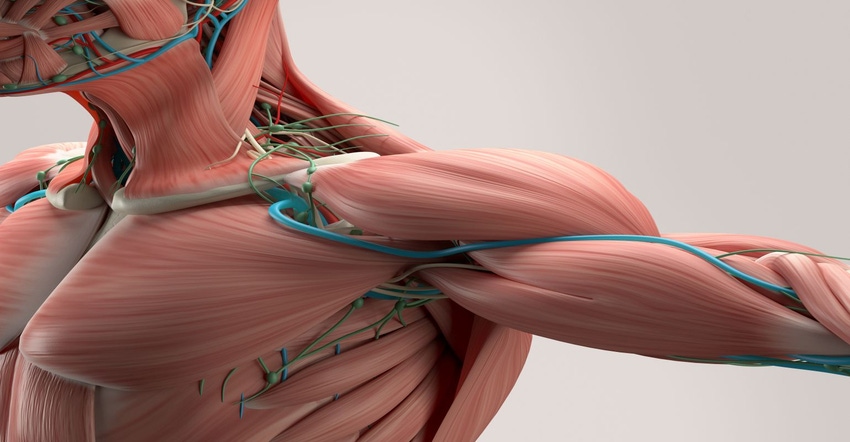Consumers are beginning to realize they can’t achieve their healthy aging and mobility goals without also addressing muscle health.

Editor’s note: This article is part two of a three-part series. Part one discussed the interconnected relationships between muscles, joints and bones. The timing is right for the nutrition and dietary supplement industries to think of musculoskeletal health as a single overarching category, particularly for formulations targeting the healthy aging community. Part two begins to examine the types of improvements that can be made to formulations to support far superior wellness outcomes.
Imagine the musculoskeletal category as a three-legged stool. Two of the legs are very well-established: bone health and joint health. A sizable glucosamine/chondroitin market is already in place for joint health. Many consumers even know about the different forms of calcium for their bones.
The weakest leg, making the whole stool (musculoskeletal system) unstable, is muscle health. In truth, joint and bone health don’t exist without muscle health. Joint pain, for example, can lead to muscle weakness as people adapt how they move or limit their movement. Weight-bearing exercise is necessary for bone health, but even walking may not be possible or practical for people whose muscle weakness makes them unstable.
Many consumers think they’ve got this covered via readily available, popular protein-fortified foods and beverages. But most people, including health care professionals, are surprised to learn protein consumption may have little impact on muscle health.
The protein conundrum
People can overconsume protein, yet in three months, muscles may not improve. While protein is necessary for building muscle, as soon as it's consumed beyond the body’s demands, the result is far more likely extra body fat—not increased muscle.
Worse, studies recently published in respected journals have shown that excessive protein intake precipitates metabolic syndrome and increased cardiovascular disease (CVD) risk factors (Curr Opin Clin Nutr Metab Care. 2020;23[6]:380-386).
Clearly protein, while essential, is an incomplete solution.
Age-related muscle loss unavoidable
Until recently, people who don’t lift weights tended to disregard the whole muscle health category, but this population has more in common with the athletic community than they realize. Both groups will experience involuntary age-related muscle loss.
Unlike joint or bone health issues, age-related muscle loss is inescapable. The body gradually becomes less efficient at replenishing muscle tissue. As a result, the body needs more protein or exercise to achieve the same muscle growth responses.
The market for products that address age-related muscle loss is poised for growth as consumers begin to realize they can’t achieve their healthy aging and mobility goals without also addressing their muscle health.
Age-related muscle loss often begins affecting the quality of life in adults over age 60. But this decline can start in people as young as 30 and is often exacerbated by lifestyle. Some young people wind up accelerating muscle loss by combining poor nutrition with multiple aggressive weight loss attempts without an exercise component. As they get older, this can compromise their entire musculoskeletal system.
The clinical name for this acceleration of muscle loss and function is sarcopenia, a condition not fully understood by many people, including some physicians. But the symptoms are common: slower recovery from illness and injuries, declining strength and energy. The progression may seem too gradual to notice—until just rising from a chair becomes a challenge.
Calcium β-Hydroxy-β-methylbutyrate or HMB fits into this scenario as a critical nutrient. It uniquely stimulates protein synthesis and reduces muscle breakdown. National Institutes of Health (NIH)-funded research showed that adding HMB (as myHMB) plus vitamin D3 to daily protein intake will improve muscle health in older adults, even without exercise (J Gerontol A Biol Sci Med Sci. 2020;75[11]:2089-2097). Vitamin D has also been correlated with muscle function. A 2021 review associated creatine supplementation with improved muscle strength, especially when combined with a resistance program (Med Sci Sports Exerc. 2021;53[11]2388-2395).
Educating consumers
Physicians must work more closely with the dietary supplement industry to maximize the synergies for their patients.
The hallmark of preventive medicine is to help consumers focus on heading off areas of susceptibility, rather than allocating efforts toward issues they’re unlikely to experience. For instance, while not everyone is susceptible to osteoporosis or arthritis, everyone will be impacted by age-related muscle loss.
Connecting the three systems
As physicians, we believe the innovative muscle health opportunities fall squarely within the dietary supplement realm. Here’s why. The pharmaceutical industry in this country focuses on therapy (treatment) once a disease is diagnosed, whereas the dietary supplement industry is focused on maintaining health.
When drugs are a common course of action—for example, a half dozen or more drugs regularly prescribed for osteoporosis—the torch is not carried by the dietary supplement industry. Bone health supplements can and should still be part of one’s program, but innovation goes on the back burner.
Over 20 years ago, no drugs were available for osteoarthritis (OA). It was the perfect time to step in with a research-backed dietary supplement program. That’s how the glucosamine/chondroitin categories were built. We’re now seeing similar circumstances with the muscle health category.
Returning to the three-legged stool analogy … strengthening the integrity of that third leg, muscle health, is significantly necessary. Because HMB is a scientifically proven approach to maintaining healthy muscle mass, it’s time to consider including this ingredient in musculoskeletal health formulations.
As people become increasingly aware of the importance of maintaining their muscle health—and how best to accomplish that—brands already in this space with well-researched ingredients stand to gain a significant portion of a global consumer base.
Naji Abumrad, M.D., (“Dr. Naji”) is an award-winning educator, board-certified surgeon, National Institutes of Health (NIH)-funded researcher, and fellow in the American Association for the Advancement of Science (AAAS).
Jason Theodosakis, M.D., (“Dr. Theo”) is a board-certified physician, bestselling author, researcher, consultant, lecturer and fellow in preventive medicine. He has a second medical specialty (sports medicine), along with master's degrees in both exercise physiology and public health. For more information, visit the Dr. Theo website.
About the Author(s)
You May Also Like






.png?width=800&auto=webp&quality=80&disable=upscale)